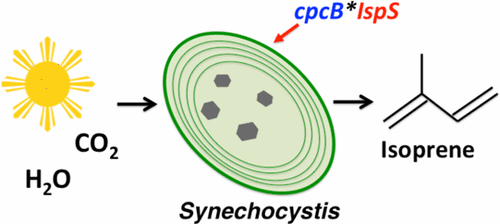当前位置:
X-MOL 学术
›
ACS Synth. Biol.
›
论文详情
Our official English website, www.x-mol.net, welcomes your
feedback! (Note: you will need to create a separate account there.)
Engineering Isoprene Synthase Expression and Activity in Cyanobacteria
ACS Synthetic Biology ( IF 3.7 ) Pub Date : 2017-08-31 00:00:00 , DOI: 10.1021/acssynbio.7b00214 Julie E. Chaves 1 , Paloma Rueda-Romero 1 , Henning Kirst 1 , Anastasios Melis 1
ACS Synthetic Biology ( IF 3.7 ) Pub Date : 2017-08-31 00:00:00 , DOI: 10.1021/acssynbio.7b00214 Julie E. Chaves 1 , Paloma Rueda-Romero 1 , Henning Kirst 1 , Anastasios Melis 1
Affiliation

|
Efforts to heterologously produce quantities of isoprene hydrocarbons (C5H8) renewably from CO2 and H2O through the photosynthesis of cyanobacteria face barriers, including low levels of recombinant enzyme accumulation compounded by their slow innate catalytic activity. The present work sought to alleviate the “expression level” barrier upon placing the isoprene synthase (IspS) enzyme in different fusion configurations with the cpcB protein, the highly expressed β-subunit of phycocyanin. Different cpcB*IspS fusion constructs were made, distinguished by the absence or presence of linker amino acids between the two proteins. Composition of linker amino acids was variable with lengths of 7, 10, 16, and 65 amino acids designed to test for optimal activity of the IspS through spatial positioning between the cpcB and IspS. Results showed that fusion constructs with the highly expressed cpcB gene, as the leader sequence, improved transgene expression in the range of 61 to 275-fold over what was measured with the unfused IspS control. However, the specific activity of the IspS enzyme was attenuated in all fusion transformants, possibly because of allosteric effects exerted by the leader cpcB fusion protein. This inhibition varied depending on the nature of the linker amino acids between the cpcB and IspS proteins. In terms of isoprene production, the results further showed a trade-off between specific activity and transgenic enzyme accumulation. For example, the cpcB*L7*IspS strain showed only about 10% the isoprene synthase specific-activity of the unfused cpcB-IspS control, but it accumulated 254-fold more IspS enzyme. The latter more than countered the slower specific activity and made the cpcB*L7*IspS transformant the best isoprene producing strain in this work. Isoprene to biomass yield ratios improved from 0.2 mg g–1 in the unfused cpcB-IspS control to 5.4 mg g–1 in the cpcB*L7*IspS strain, a 27-fold improvement.
中文翻译:

工程异戊二烯合酶在蓝细菌中的表达和活性
通过蓝细菌表面屏障的光合作用,从CO 2和H 2 O异源生产大量异戊二烯碳氢化合物(C 5 H 8)的努力,包括低水平的重组酶积聚和缓慢的先天催化活性。本工作试图减轻异戊二烯合酶(IspS)与cpcB蛋白(藻蓝蛋白的高度表达的β亚基)融合在一起后的“表达水平”障碍。不同的cpcB * IspS制备了融合构建体,区别在于两种蛋白质之间不存在接头氨基酸。接头氨基酸的组成是可变的,长度为7、10、16和65个氨基酸,旨在通过cpcB和IspS之间的空间定位来测试IspS的最佳活性。结果表明,与未融合的IspS对照相比,以高度表达的cpcB基因作为前导序列的融合构建体将转基因表达提高了61至275倍。但是,IspS酶的比活性在所有融合转化子中都会减弱,这可能是由于前导cpcB融合蛋白发挥了变构作用。这种抑制作用取决于cpcB和IspS蛋白之间的接头氨基酸的性质。就异戊二烯的生产而言,结果进一步显示了比活性和转基因酶积累之间的权衡。例如,cpcB * L7 * IspS菌株仅显示未融合cpcB-IspS对照的异戊二烯合酶特异性活性的10%,但它积累了254倍的IspS酶。后者不仅抵消了较慢的比活,而且使cpcB * L7 * IspS转化体成为这项工作中产生异戊二烯的最佳菌株。异戊二烯与生物质的产量比从未融合的cpcB-IspS对照中的0.2 mg g -1提高到cpcB * L7 * IspS菌株中的5.4 mg g -1,提高了27倍。
更新日期:2017-08-31
中文翻译:

工程异戊二烯合酶在蓝细菌中的表达和活性
通过蓝细菌表面屏障的光合作用,从CO 2和H 2 O异源生产大量异戊二烯碳氢化合物(C 5 H 8)的努力,包括低水平的重组酶积聚和缓慢的先天催化活性。本工作试图减轻异戊二烯合酶(IspS)与cpcB蛋白(藻蓝蛋白的高度表达的β亚基)融合在一起后的“表达水平”障碍。不同的cpcB * IspS制备了融合构建体,区别在于两种蛋白质之间不存在接头氨基酸。接头氨基酸的组成是可变的,长度为7、10、16和65个氨基酸,旨在通过cpcB和IspS之间的空间定位来测试IspS的最佳活性。结果表明,与未融合的IspS对照相比,以高度表达的cpcB基因作为前导序列的融合构建体将转基因表达提高了61至275倍。但是,IspS酶的比活性在所有融合转化子中都会减弱,这可能是由于前导cpcB融合蛋白发挥了变构作用。这种抑制作用取决于cpcB和IspS蛋白之间的接头氨基酸的性质。就异戊二烯的生产而言,结果进一步显示了比活性和转基因酶积累之间的权衡。例如,cpcB * L7 * IspS菌株仅显示未融合cpcB-IspS对照的异戊二烯合酶特异性活性的10%,但它积累了254倍的IspS酶。后者不仅抵消了较慢的比活,而且使cpcB * L7 * IspS转化体成为这项工作中产生异戊二烯的最佳菌株。异戊二烯与生物质的产量比从未融合的cpcB-IspS对照中的0.2 mg g -1提高到cpcB * L7 * IspS菌株中的5.4 mg g -1,提高了27倍。











































 京公网安备 11010802027423号
京公网安备 11010802027423号